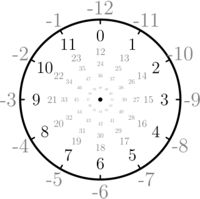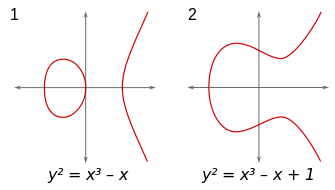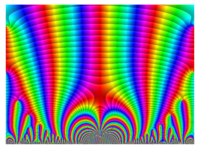Contents
Modular Forms
Nick Castaneda
Table of Contents
1. Introduction
2. Modular Arithmetic
3. Qualities of Modular Forms
4. Applications
5. References and Further Reading
1. Introduction
German number theorist Martin Eichler said that the five essential operations of mathematics were addition, subtraction, multiplication, division, and modular forms. And three of those are just variations of addition. Modular forms are a complicated but incredibly interesting group of functions. The most satisfying way to examine a modular form is by looking at its graph: most are symmetric in multiple ways, creating complex and intricate patterns. Modular forms are different from most of the functions that you have dealt with, as they exist in an imaginary plane, but the impact they’ve had on our understanding of mathematics is very real. Multiple aspects of math and science have been found to connect to modular forms, and they have been the key to solving some of the most renowned mathematical proofs.
2. Modular Arithmetic
Modular forms get one half of their name from modular arithmetic, the operation that they are based in. Even if you don’t realize it, you already use modular arithmetic in your everyday life, such as when you look at a clock. If it is currently 10 o’clock and you wanted to know what time it will be in 5 hours, what calculation would you perform? If you added them together it would give you 15, which obviously isn’t the correct answer. Instead you need to subtract 12, since that is the largest integer on a clock, leaving you with 3. This is a simplified version of operating in mod 12, in which values are measured in relation to the nearest multiple of 12. We would say that 3 and 15 are congruent in mod 12, since both numbers are 3 greater than the nearest multiple of 12. This works for any set of integers, as 9 and 17 are congruent in mod 4, or 6 and 83 are congruent in mod 7.
No matter what mod you are using, increasing the value over time will create a cyclical pattern. If you are measuring the value of A in mod x, and you increase A indefinitely, the value will increase until it reaches a multiple of x. Then the value will become 0 and start increasing again. This is similar to how a clock will never show a value greater than 12, it will only revert back to 1 and restart the cycle.
If we were to write out an equation that showed the cycle of time, it would be $ f(x)= f(x+12) $ for $ x>0 $ and $ x∈Z $
This shows that the function will repeat its value in 12 units. The graph would be a line with slope 1 that would return to a value of 1 when x reached 13. This pattern would repeat infinitely along the x-axis.
While this equation doesn’t quite meet the criteria of a modular form, it helps to show the makeup of the more complex modular forms. Modular forms and the time function both have translational symmetry because they have repeating sections. However modular forms have other kinds of symmetry as well including reflectional symmetry and scaling symmetry, meaning that the design repeats at different sizes.
3. Qualities of Modular Forms
While there are a number of functions that deal with modular arithmetic, modular forms must meet a very specific set of criteria. Modular forms only exist in what is called the upper half plane, which is the similar to the xy-plane, but y can only be positive, complex numbers.
The first condition is that a modular form must be holomorphic, which essentially means differentiability for a complex function.
The second condition is the one that modular forms are best known for:
$ f(\frac{az+b}{cz+d}) = f(z) * (cz+d)^k $
I know that this equation looks daunting, but we can break it down into parts that are easier to understand. The calculation of z isn’t really the most important part. It's just the result of the real and imaginary components that we’re dealing with. You can think of it as z= x + iy
The variables a,b,c,d come from what is called a SL(2,Z) matrix, which is shorthand for a 2x2 matrix made up of integers with determinant 1.
$ \begin{bmatrix} a & b \\ c & d \end{bmatrix} $
where ad-bc=1
and all variables are integers
This condition will be true for every possible SL(2,Z) matrix. The variable k is the weight of the modular form. The weight is usually given, so you won’t have to solve for it very often. All weights are positive integers, and the zero function is the only modular form with an odd weight, so k will almost always be even.
Let’s see what this condition looks like in practice. The formula is easier to compute with lower numbers, so we’ll start with the matrix:
$ \begin{bmatrix} 1 & 1\\ 0 & 1 \end{bmatrix} $
This matrix fits our criteria since it is 2x2 and has determinant 1. This gives us the equation:
$ f(\frac{z+1}{1}) = f(z) * (1)^k $ which can be simplified to $ f(z+1)=f(z) $
This shows us that our modular form repeats itself every unit, similar to our earlier time function.
Another matrix that fits this criteria is:
$ \begin{bmatrix} 0 & -1\\ 1 & 0\end{bmatrix} $
Resulting in $ f(\frac{-1}{z}) = f(z) * (z)^k $ which is harder to visualize but is still an important part of the form.
A good rule of thumb to use is that if a modular form works with both of these matrices, then it likely meets the second condition, but there are countless matrices that are considered SL(2,Z)
The third condition of modular forms is that as the imaginary component of z approaches infinity, the function should remain bounded.
Now that we understand the constraints that define a modular form, we can see what equations represent them.
There are a few different ways to represent modular forms, but the most common is with a power series.
$ E_k (z)= \sum_{m,n∈Z^2}(mz+n)^{-k} $
This is named the Eisenstein form after its creator, Gotthold Eisenstein. Instead of going from 0 to infinity like a one-variable series, this power series represents the sum of the values of every possible integer combination of m and n, as long as they aren't both 0. A modular form that fits this equation will exist for every even weight greater than 2.
4. Applications
Obviously, modular forms are incredibly cool, but it can be difficult to see how a small set of functions in an imaginary plane can be applied to the rest of mathematics. While they may appear to be extremely isolated, modular forms are related to more parts of math than you might think.
One of the most prevalent uses of modular forms is their relation to elliptic curves. Elliptic curves are based in the xy-plane, have a variety of uses, and, while they may appear simple, are actually fairly complicated.
$ y^2=x^3+ax+b $ is the general equation used for elliptic curves
The most common application of elliptic curves is in cryptography, since it is easy for a computer to identify a point on an elliptic curve when given instructions but nearly impossible for a third party to recreate the instructions, even if given the final point.
Elliptic curves are connected to modular forms through the Taniyama-Shimura conjecture, which has been known as the modularity theorem since it was proven in 2001. This theorem states that every elliptic curve has a corresponding modular form. This is similar to how every cylinder has a corresponding circle when projected from $ R^3 -> R^2 $. The projection takes a very different form in this case since we are projecting into an imaginary plane. However it is still similar to any other projection since we can convert any elliptic curve into a modular function. Therefore, we can create an elliptic curve that fits a given modular form, or we can even prove that an elliptic curve doesn’t exist by proving it doesn’t correspond to a modular form.
Perhaps the most famous example of application of modular forms was their use in proving Fermat’s Last Theorem. The French mathematician Pierre de Fermat has a number of theorems named after him, (Fermat’s Little Theorem is used in modular arithmetic), but after his death in 1665, even more of his work was discovered in his unpublished notes. Fermat had written his Last Theorem in one of his notebooks but hadn’t included a proof.
$ a^n + b^n = c^n $
will never be true when all variables are integers and n>2
For centuries, the theorem existed in a state of flux, as mathematicians were unable to prove the equation, but couldn’t find any counterexamples either. However, one large development was made by Yves Hellegouarch in the late 1960s when he proved that a solution to Fermat’s equation could be written as an elliptic curve in the form: $ y^2 = x (x-an) (x+bn) $
In 1995, Andrew Wiles was able to build on this, as well as theorems generated by other mathematicians, to prove that this elliptic curve did not correspond to a modular function. Since it had already been shown that all elliptic curves are modular, Wiles was able to prove that this curve was impossible and that there was no possible solution to $ a^n + b^n = c^n $ with the given constraints.
Though they initially appeared unrelated, modular forms were the key to proving one of the most well-known theorems in mathematics.
5. References and Further Reading
This article is brief but provides an understandable breakdown of modular functions
https://medium.com/cantors-paradise/what-are-modular-forms-6d19c9547b2
A comprehensive explanation of Elliptic curves
https://encyclopediaofmath.org/index.php?title=Elliptic_curve
This video discusses how elliptic curves are used in cryptography
https://www.youtube.com/watch?v=NF1pwjL9-DE
Wikipedia isn't an ideal source but it covers a wide range of information
https://en.wikipedia.org/wiki/Modular_form
This professor has an 8-part lecture series on modular forms
https://www.youtube.com/watch?v=LolxzYwN1TQ
This is a longer read but goes into detail of Wiles' proof of Fermat's Last Theorem
https://www.ams.org/publications/journals/notices/201703/rnoti-p209.pdf








